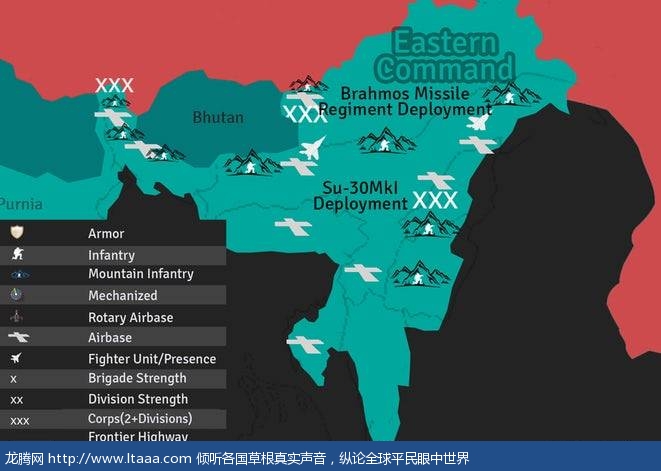印度能在有限军事冲突中给中国上一课么? [印度媒体]
印度是否可以在实际控制线或锡金邦边界抵挡住中国的进攻么?答案隐藏在对于两国在边界部署军力的聚集和战力情况的分析中。当7月18日,南华早报报道中引用官方渠道声称解放军已经将上万吨军事装备和设备运往XZ。这仅是过去一周来数次军事部署之一,配结合着中国外交部激进的言论和中国国有媒体露骨的战争咆哮,引发了印度国内对潜在战争的争论......
Can India Embarrass China In A Limited Military Conflict?
印度能在有限军事冲突中给中国上一课么?
Can India ward off a limited Chinese attack along the Line of Actual Control or the international boundary in Sikkim?
The answer lies in analysing force concentration and capabilities that the two countries bring to bear on the common border.
印度是否可以在实际控制线或锡金邦边界抵挡住中国的进攻么?答案隐藏在对于两国在边界部署军力的聚集和战力情况的分析中。
1、On 18 July, the South China Morning Post reported that China's People’s Liberation Army (PLA) had moved “tens of thousands of tonnes of military vehicles and equipment into Tibet”, quoting the PLA mouthpiece. Many such moves in the past one week, seen in the light of aggressive statements made by China’s foreign ministry and the blatant warmongering rhetoric from the country’s state-owned media, has triggered a debate in India. Although reports suggest that the PLA has not mobilised troops towards the border with India and that the recent live-fire exercise in Tibet was a routine affair – putting off the chances of a full-blown military conflict, prospects of a peaceful walk-back from the brink appear to be shrinking with every passing day.
当7月18日,南华早报报道中引用官方渠道声称解放军已经将上万吨军事装备和设备运往XZ。这仅是过去一周来数次军事部署之一,配结合着中国外交部激进的言论和中国国有媒体露骨的战争咆哮,引发了印度国内对潜在战争的争论。尽管这篇报道显示解放军并未向边境部署部队且近期XZ的实兵演习仅仅是例行安排,这减少了全面军事冲突的可能性,但是从交火走向和平的可能性正逐步减少。
2、Though the Doklam crisis will most likely not lead to war, a localised conflict is indeed possible if the PLA decides to up the ante – something China recently indicated as possible.
尽管郎洞危机很可能不会引发战争,但局域冲突的可能性依然存在,尤其是在解放军加大赌注情况下,正如中国最近暗示的一样。
3、Under these circumstances, the question that arises is if India can ward off a limited Chinese attack along the Line of Actual Control (LAC) or the international boundary in Sikkim. The answer lies in analysing force concentration and capabilities that the two countries bring to bear on the common border.
考虑到这些情况,自然而然的问题就是印度是否可以在实际控制线或锡金邦边界抵挡住中国的进攻么?答案隐藏在对于两国在边界部署军力的聚集和战力情况的分析中。
4、There are some enduring misconceptions about the military balance along the Sino-Indian border. The most common of these is that China’s localised military strength along the border far outweighs India’s. However, studying the deployment of troops and air assets along the border, and particularly in Sikkim – the site of the current stand-off, one arrives at an entirely different picture.
公众对关于中国边界军事力量平衡的问题一直存在误解。其中最普遍的一条是中国在边境地区的军事力量远强于印度。但是,通过对于陆军和空军部署的分析,会得出截然不同的结论,尤其在目前发生对峙的锡金邦。
Ground Forces
陆军
Eastern Sector
东线
5、The Indian Army has nine of its 12 mountain divisions deployed in the eastern sector. Each of these divisions usually consists of 15,500 combat troops and 8,000 support elements. Of these, three divisions – seventeenth, twenty-seventh and twentieth – are deployed near the India-China-Bhutan tri-junction, the site of the ongoing stand-off. These divisions are based in Gangtok (Sikkim), Binnaguri (West Bengal) and Kalimpong (West Bengal) respectively, guarding India’s vulnerable chicken’s neck, the Siliguri Corridor, which connects seven northeastern states with the rest of India.
印度陆军将其12个山地师中的9个部署在东线。每个师一般包括15500作战部队和8000人的支援部队。其中,第17、27和20师部署在目前发生对峙的印-中-不三方边境。这三个师分别部署在Gantok(锡金邦),Binnagguri(西孟加拉邦),Kalimpong(西孟加拉邦),防守着脆弱的印度鸡脖——西里古里走廊,该走廊连接着印度东北邦和印度其他地区。
6、Three mountain divisions – fifth, twenty-first and seventy-first – are deployed in Bomdila (Arunachal Pradesh), Rangiya (Assam) and Missamari (Assam). Bomdila is located just 170km from Tawang, an important centre of Tibetan Buddhism claimed by China as a part of the Tibetan Autonomous Region (TAR). Additionally, three mountain divisions of the Indian Army – second, fifty-sixth and fifty-seventh – are deployed in Dibrugarh (Assam), Zakhama (Nagaland) and Leimakhong (Manipur) respectively.
第五师、第二十一师和第七十一师分别部署在Bomdila(阿鲁纳恰尔邦,咱们的藏南)、Rangiya(阿萨姆邦)和Missamari(阿萨姆邦)。Bomdila距离达旺170公里,后者是藏传佛教中心,中国认为是其XZ自治区的一部分。此外,第二师、第56师和第57师分别部署在Dibrugarh(阿萨姆邦 )、Zakhama(那加兰邦)以及Leimakhong(曼尼普尔区)。
Sino-Indian border deployments (units located via IHS Jane’s database, August 2016)
东线中印边境军事部署(部队部署位置参考简氏数据库,2016年8月)
7、Against this, China has two mountain motorised infantry brigades and a mechanised infantry brigade close to the Indian border. While the mountain infantry brigades are based in Nyingchi region of Tibet facing Arunachal Pradesh, the only mechanised infantry brigade deployed close to the LAC is stationed in Lhasa, Tibet’s capital.
中国方面,在印度边界部署有两个山地机械化步兵旅和一个机械化步兵旅。山地机械化步兵旅部署在藏南对面的林芝地区,其余离实际控制线最近的步兵旅则部署在拉萨,XZ首府。
Western Sector
西线
8、In the western sector, India has an infantry division and a mountain division. While the former is stationed in Leh, the latter is based in Dras. India also has an armoured brigade (with over 100 T-72 tanks) to cover the flat approaches from Tibet towards India’s crucial defences at Chushul.
在西线,印度部署有一个步兵师和一个山地师。前者驻扎在Leh,后者驻扎在Dras。此外印度还有一个装甲旅(装备有100辆t-72坦克),可以防守从印度战略要地Chushul到XZ的平缓地区。
9、The Indian side of the LAC in Ladakh sector is much more conducive for mechanised warfare than the Chinese side. In the Sino-Indian war of 1962, six vintage AMX-13 tanks of the Indian Army, which were airlifted to Chushul, inflicted severe losses and delay on the advancing Chinese Army.
与中国相比,拉达克地区实际控制线印度一侧更适合机械化部队作战。在1962的中印边界战争中,空运到Chushul的6辆AMX-13坦克给中国军队造成了严重杀伤并拖延了其推进。
10、In comparison, China has deployed a mechanised infantry division based in Hotan in the Xinjiang Autonomous Region, north of Askai Chin – a part of Jammu and Kashmir that China currently occupies and claims as its own.
与之相比,中国在阿克塞钦以北的XJ和田地区部署有一个机械化步兵师,阿克塞钦是中控克什米尔的一部分,目前中国控制并声称是其领土。(1962年我们打下来的,连接XJ和XZ,战略要地 )
Sino-Indian border deployments (units located via IHS Jane’s database, August 2016)
西线中印边境军事部署(部队部署位置参考简氏数据库,2016年8月)
11、Therefore, in terms of the number of troops deployed close to the boundary in both eastern and western sectors, India possesses a clear advantage.
因此,无论东线还是西线,但从边境部署军队的数量来看,印度有明显优势。
12、However, a simple bean-counting approach to the Sino-Indian military balance has limits. China’s newly carved out the western theatre command, which is tasked all along the Sino-Indian border, is known to have three Group Armies (corps-level military formations). Although stationed away from the border, China’s superior infrastructure allows it to quickly move troops, such as its Rapid Reaction Forces (RRF) that it has raised in the last two decades, to the conflict zone. China has also built a number of oxygen-rich, hyperbaric chambers in order to quickly acclimatise the forces it will bring from other parts of the country to the war front.
当然,这种简单的数豆子的方法在衡量中印军事力量有明显局限。中国新组建、面向中印边界的西部战区据称拥有三个军。尽管其军事力量部署远离边境,但是中国占优的交通技术设施可使其更加迅速的部署诸如在过去二十年逐步建立的快速反应部队。中国还建设有多个高氧仓,可以使得从其他地方调集的部队迅速适应高原环境,开往前线。
13、By some accounts, China can use RRF groups based in its western theatre against India within three to five days of having taken a decision to do so. This will erode the advantage that India has in terms of the number of troops deployed close to the border.
根据估计,如果一旦下令,中国可以在三到五天内从西部战区调集快速反应部队对抗印度。这会抵消印度前线布置军队的数量优势。
14、While India has made some progress in terms of infrastructure development in certain areas such as Arunachal Pradesh, most of India’s road and rail construction projects have fallen victim to considerable delays.
于此相比,印度在藏南地区的基础设施建设确实取得了一个成绩,但其他地区的公路和铁路建设均远远落后于进度。
Air Force
空军
15、As many as 31 Indian airfields – nine in the western and 22 in the eastern sector – are located close to the LAC. These include air bases in Leh, Jalpaiguri (closest Indian air base to the Chumbi Valley), Chabua (Assam) and Tezpur (Assam). Bases in Chabua and Tezpur are particularly important because of their proximity to the LAC and the presence of the front-line Sukhoi-30MKI fighters. Indian airbases in the northern plains, including those in West Bengal, can be used against China.
印度在实际控制线附近建设有31个机场,9个在西线,22个在东线。这些机场报考位于Leh、Jalpaiguri(距Chumbi峡谷最近的空军基地)、Chabua和Tezpur的空军基地。Chabua和Tezpur的空军基地尤其重要,这两基地距实际控制线很近且部署有苏30MKI战斗机。印度北部平原的机场,包括位于西孟加拉邦的机场均可用于对抗中国。
16、In addition, India has multiple advance landing grounds (ALG), such as the one in Daulat Beg Oldi (Ladakh), on which it has landed its heavy-lift aircraft. In the past few years, the Indian Air Force (IAF) has also operationalised multiple ALGs in Arunachal Pradesh and Ladakh, most recently in Ziro and Along. These ALGs augment IAF’s ability to operate from forward areas.
此外,印度还建设有多个高级起降场,如位于Daulat Beg Oldi的高级起降场可以起降重型运输机。过去五年,印度空军在藏南和拉达克运行了多个高级起降场,最近启用的包括Ziro和Along。这些设施扩展了印度空军在前线作战的能力。
Location of air bases along the Sino-Indian border.
中印边境空军设施部署
17、In comparison, the People’s Liberation Army Air Force (PLAAF) has nine major airfields in its western theatre command, which it can use to launch conventional air operations against India. These include bases in Hoping, Bangda, Shiquanhe, Bayixincun (facing Arunachal Pradesh) and Kongka. China also has airfields in Lhasa, Shannan and XIgaze, which it can make operational in short time. One of its bases in Tibet's Nyingchi prefecture is just 30km away from Arunachal Pradesh. It also has a score of tactical airstrips and helipads spread across the region.
与之对比,中国解放军空军在西线有9个可用于空军作战的基地,其中包括和田、邦达、四泉河、八一新村和康达。中国还在拉萨、山南、西嘎子地区有跑道,可在短时间内投入运行。林芝县的空军基地距离藏南地区仅30公里。在整个边境地区还建设有许多战术跑道和直升机机场。
18、However, most of PLAAF’s air bases in Tibet are located at an altitude of 4,500 metres. This puts the PLAAF in a competitive disadvantage vis-à-vis IAF when deploying fighter jets on the Tibetan plateau because the load-carrying capability of the jets degrades significantly when they take off from bases at high altitudes. Due to reduced payload, the PLAAF has to cut down on the amount of ammunition and quantity of fuel its fighter jets can carry, significantly affecting its combat capabilities. The IAF, on the other hand, can operate with ease from its many airfields located in the plains in both the western and eastern theatres without compromising on its payload capabilities.
但是,多数中国空军基地位于海拔4500米以上。这对中国空军不利,因为高原起降限制战机起飞重量。由于起飞重量的限制,中国战机可携带的弹药和油料将减少,显着影响其作战能力。印度空军的战机可从东线和西线诸多机场起飞,不用担心起飞重量的影响。
19、Lack of support infrastructure in these bases is also a concern for the PLAAF. Most of these bases lack hardened shelters to protect aircraft on the ground, leaving them vulnerable to attacks. Rudimentary support infrastructure would make it difficult for the PLAAF to carry out large-scale air operations in a sustained manner.
辅助基础设施的缺乏也是解放军空军需要担心的一点。多数空军基地缺乏硬质机库,而且简易的辅助设施使得解放军空军难以持续开展大规模空军作战。
PLAAF airfields in Tibet lacking support infrastructure (ETH Zürich)
中国空军缺乏辅助设施
20、In the Chengdu military region facing Arunachal and Lanzhou military region facing Jammu and Kashmir, which have now been largely merged to form the new western command, the PLAAF is know to have four fighter divisions, one transport division and one bomber division. All these divisions are currently based outside Tibet. Due to the lack of support infrastructure on the Tibetan plateau, the PLAAF cannot bring all of its air capabilities to the region. This significantly erodes the quantitative advantage that the PLAAF enjoys over the IAF. Moreover, the relatively long lines of communication for Chinese forces, strung across Tibet, would be vulnerable to interdiction by the IAF.
应对藏南的成都军区和应对克什米尔的兰州军区目前融合成为西部战区,在该战区中,中国空军部署有4个空战师,1个运输师,1个轰炸师,均部署在XZ以外。由于XZ高原地区辅助设施的缺乏,中国空军难以将其全部空军力量部署到该地区。这显着降低了中国空军对印度的数量优势。此外,横贯XZ的漫长的交通路线也使得中国军队容易受到印度空军分封锁。
21、In comparison, most Indian air bases in both eastern and western sectors have sufficient support infrastructure, including reinforced aircraft hangars.
对比来看,绝大多数东线和西线印度空军基地均有足够的辅助设施,包括加固机堡。
An aerial view of the Leh airfield showing aircraft shelters
航空摄影展示Leh机场的机堡
22、Therefore, India possesses an edge in air power along the LAC. However, the advantages that India has are eroding rapidly, largely due to the decreasing size of India’s fighter fleet and the deployment of China’s integrated air defence network in Tibet. By 2025, China will likely have more airfields in the wider Tibetan region, significantly increasing its ability to use air power against India.
因此,在实际控制线印度享有制空优势。但是这种优势难以持续,这主要因为印度空军战机数量的下降和中国在XZ地区防空网的建设。预计到2025年,中国将在大XZ地区建设更多的机场,显着增加中国空军的能力。
23、In the broader sense, China has a numerical advantage over India in almost every area. But, along the border, India enjoys both operational and numerical superiority. This is clear when one looks at the character of force deployment and capabilities that the two countries bring to bear along the common border. So, can India embarrass China in a limited military conflict along the border? It likely can.
广义来说,中国几乎每个领域均享有数量优势。但是在边境附近,印度拥有可运用和数量优势。这点在分析两国边境地区军力的发展和部署后十分清晰。因此,印度在小范围的军事冲突中能给中国上一课么?很可能。
24、Former national security adviser Shivashankar Menon, in his book Choices, argues along similar lines. Beijing, Menon writes, backed down in the 2013 incursion at the Depsang valley in Kashmir’s Ladakh region “because of India’s improved capabilities, which left the Chinese in no doubt that India could embarrass them”.
前国防顾问Shivashankar Menon在他的书《选择》中提到了相同的论述。Menon写到,北京之所以在2013年Depsang 谷地冲突撤退的主要原因就是在于印度军力的进步,使得中国人明确的意识到印度能够教训自己。
25、India’s diplomatic efforts, he states, “have focused on convincing China that any misadventure would result in embarrassment and pain”.
因此他写到,印度的外交手段应该用在让中国知道误判只会给自己带来耻辱和痛苦。
版权声明
我们致力于传递世界各地老百姓最真实、最直接、最详尽的对中国的看法
【版权与免责声明】如发现内容存在版权问题,烦请提供相关信息发邮件,
我们将及时沟通与处理。本站内容除非来源注明五毛网,否则均为网友转载,涉及言论、版权与本站无关。
本文仅代表作者观点,不代表本站立场。
本文来自网络,如有侵权及时联系本网站。
图文文章RECOMMEND
热门文章HOT NEWS
-
1
चाइना में रेडी और ठेले Local shops in china || L...
- 2
- 3
- 4
- 5
- 6
- 7
- 8
- 9
- 10
推荐文章HOT NEWS
-
1
चाइना में रेडी और ठेले Local shops in china || L...
- 2
- 3
- 4
- 5
- 6
- 7
- 8
- 9
- 10
















